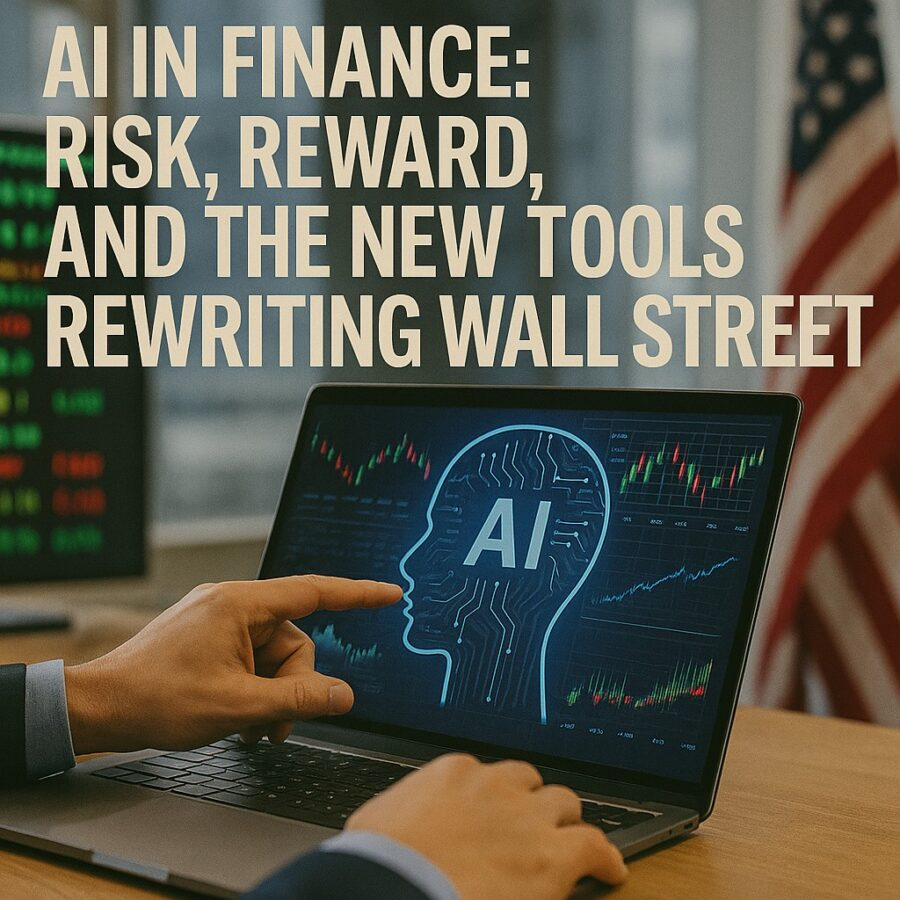Views: 1
For centuries, finance has revolved around human judgment, instinct, and analysis. Traders, bankers, and analysts relied on experience as much as equations. That world is now shifting. The rise of AI in Finance is redefining the balance between risk, reward, and control. From hedge funds deploying machine learning algorithms to retail investors using robo-advisors, artificial intelligence is no longer peripheral. It sits at the heart of decision-making on Wall Street.
This article examines how AI tools are changing the financial industry, the risks that follow, and the rewards that draw so much investment into the space.
Why AI Matters in Finance
The financial sector thrives on patterns, predictions, and rapid responses. Markets move at the speed of information. Human traders cannot process millions of data points simultaneously, but machines can. This capacity explains why AI in Finance has become indispensable.
AI systems digest news headlines, social media sentiment, historical data, and economic indicators in real time. They provide insights that would take human teams weeks to compile. This shift places artificial intelligence at the center of market forecasting, portfolio management, and risk assessment.
The following is a referral or affiliated link that AltPenguin receives compensation for, should the link be used and the offer is completed. To provide full transparency, we at AltPenguin are stating this before you click the image below (the image will open a new page to the offer shown in the image).
The New Tools Rewriting Wall Street
The current generation of AI tools goes far beyond spreadsheets and statistical models. Several categories stand out.
Algorithmic Trading
AI-driven algorithms execute trades within milliseconds, exploiting small price discrepancies that humans cannot detect. These systems adapt dynamically, learning from past results to refine strategies.
Robo-Advisors
Platforms such as Betterment and Wealthfront use machine learning to build portfolios tailored to individual investors. They automate rebalancing and tax-loss harvesting, offering services once limited to high-net-worth clients.
Fraud Detection
AI scans transactions for suspicious patterns. Banks use machine learning to flag potential fraud more accurately than traditional systems, reducing false alarms while improving security.
Credit Scoring
Beyond FICO, new AI models evaluate alternative data such as utility payments and online activity. This approach expands access to credit for individuals without traditional financial histories.
These innovations illustrate how AI in Finance is rewriting the rulebook across every corner of Wall Street.
The Reward: Efficiency and Access
The benefits of adopting AI tools are significant.
- Speed and scale: Markets are global, and AI handles complex datasets at a pace no human team can match.
- Cost reduction: Automating advisory services reduces overhead and broadens access to financial planning.
- Personalization: Investors receive tailored advice rather than generic recommendations.
- Expanded inclusion: Alternative credit scoring helps underserved populations gain access to loans.
The reward of AI in Finance is clear: faster, cheaper, and more inclusive systems that promise to democratize wealth management while boosting institutional profits.
The Risk: Volatility and Bias
The rewards are matched by risks that regulators and institutions are only beginning to confront.
- Market instability: Algorithms acting in parallel can trigger sudden volatility, as seen in flash crashes.
- Opaque decision-making: AI models are often black boxes, making it difficult to understand why they recommend specific trades or deny loans.
- Bias amplification: Credit-scoring systems trained on biased data may reinforce existing inequalities rather than resolve them.
- Cybersecurity threats: As more financial operations depend on AI, the risk of malicious tampering grows.
The rise of AI in Finance demands safeguards to ensure that efficiency does not come at the expense of stability or fairness.
The following is a referral or affiliated link that AltPenguin receives compensation for, should the link be used and the offer is completed. To provide full transparency, we at AltPenguin are stating this before you click the image below (the image will open a new page to the offer shown in the image).
Case Studies of AI on Wall Street
Several examples illustrate the power and peril of this transition.
- Hedge Funds: Renaissance Technologies and Two Sigma rely heavily on AI models to identify trading opportunities, often with results that outperform human-managed funds.
- Retail Trading Apps: Robinhood has integrated AI to improve user experience and risk management. Yet critics argue that algorithmic nudges encourage risky behavior among inexperienced traders.
- Fraud Prevention: JPMorgan Chase uses AI to monitor billions of transactions, catching fraudulent activity with greater accuracy.
These cases reveal how AI in Finance operates at multiple levels, from elite hedge funds to everyday banking.
Regulation and Oversight
Governments and regulators now face the challenge of keeping pace. The Securities and Exchange Commission has raised concerns about algorithmic transparency. The European Union’s AI Act proposes strict standards for high-risk applications in finance.
The central issue is accountability. If an AI system causes financial harm, who bears responsibility? The firm that deployed it, the programmers who built it, or the investors who used it? Clarity in regulation will determine how safely AI in Finance develops.
The Human Factor
Despite automation, humans remain central. Financial advisors who use AI tools can focus on relationship-building rather than repetitive tasks. Analysts can interpret model outputs within broader economic contexts.
The rise of AI in Finance does not eliminate human judgment but reframes it. Machines supply insights at scale, while people provide ethical oversight, empathy, and big-picture strategy. The most successful institutions will blend artificial intelligence with human expertise.
Global Implications
AI is not only rewriting Wall Street but reshaping finance worldwide.
- Asia: China’s Ant Group integrates AI into mobile banking and credit scoring for millions of users.
- Europe: Fintech startups in London use AI for compliance and fraud detection.
- Africa: Mobile money platforms use AI to extend credit to populations outside traditional banking systems.
The global spread of AI in Finance ensures that the transformation is not limited to developed markets. It is a worldwide restructuring of how money moves.
The Cultural Dimension
Money is not just numbers. It reflects values, trust, and human behavior. AI alters that culture by removing emotion from decisions. Some argue this creates fairness and consistency. Others fear it removes humanity from financial systems that should account for context and compassion.
The cultural shift of AI in Finance will shape how people view wealth, risk, and responsibility in the coming decades.
Preparing for the Future
How can individuals and institutions prepare?
- Invest in literacy: Professionals must understand AI tools, not just outsource responsibility.
- Balance automation with oversight: AI can guide decisions, but humans must set ethical boundaries.
- Engage regulators early: Firms should help shape rules that encourage innovation without risking instability.
- Adapt skill sets: Analysts who learn to work with AI will remain valuable even as routine tasks vanish.
Preparing for the age of AI in Finance means embracing the technology while guarding against complacency.
A Balanced Perspective
It is tempting to frame AI as either savior or villain. The truth is more nuanced. Artificial intelligence amplifies both strengths and weaknesses in finance. It can expand access to credit while also magnifying inequality. It can stabilize markets by detecting fraud yet destabilize them with algorithmic herd behavior.
The story of AI in Finance is one of duality. Risk and reward are inseparable, and the outcome depends on choices made by institutions, regulators, and individuals.
The following is a referral or affiliated link that AltPenguin receives compensation for, should the link be used and the offer is completed. To provide full transparency, we at AltPenguin are stating this before you click the image below (the image will open a new page to the offer shown in the image).
Closing Thoughts
The new tools rewriting Wall Street represent both promise and peril. Artificial intelligence offers speed, efficiency, and access unmatched in human history. Yet it also introduces complexity, opacity, and risk.
The future of AI in Finance will depend on balance: the ability to harness computational power without abandoning transparency, fairness, or human oversight.
As with past revolutions, winners will be those who adapt wisely. Wall Street is being rewritten, but the pen is in both human and machine hands.





